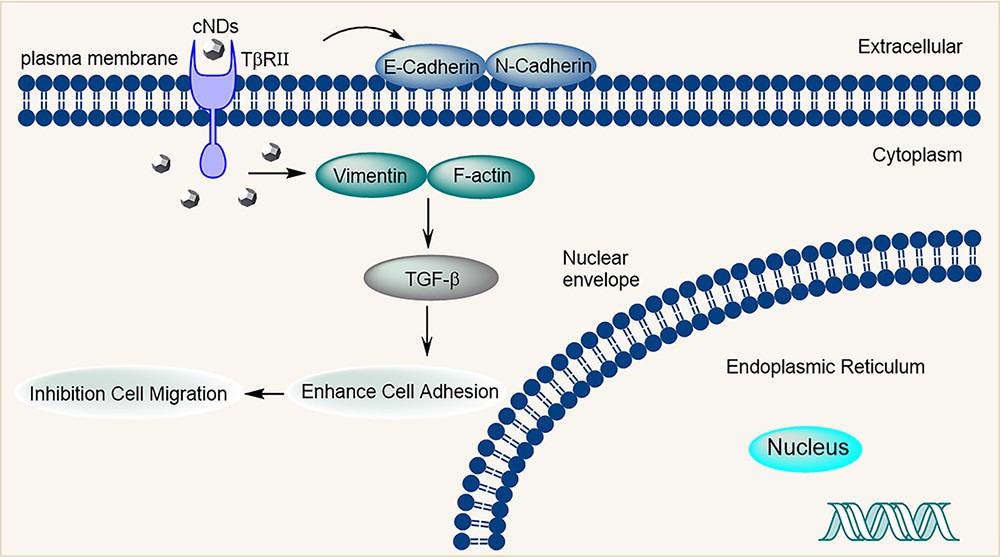Mar 18 2021
Recently, researchers from China analyzed and found that carboxylated nanodiamonds (cNDs) could support the adhesion of tumor cells to the underlying substrate, thereby restricting the motility of tumor cells.
 Scheme of inhibition of tumor cell migration by cNDs. Image Credit: Zhi et al.
Scheme of inhibition of tumor cell migration by cNDs. Image Credit: Zhi et al.
The cNDs are materials with high chances of finding applications in future cancer treatment. Published in ACS Applied Materials & Interfaces, the new study was performed by Prof. Jinfang Zhi’s group from the Technical Institute of Physics and Chemistry (TIPC) of the Chinese Academy of Sciences (CAS).
In the field of medicine, cancer treatment is still a crucial problem at present. The metastasis of cancer cells is one of the widespread causes of mortality in cancer patients. This is because the mechanism of migration of tumor cells is unacquainted and tricky.
Since 2010, the team of researchers headed by Prof. Zhi has been investigating the application of NDs materials system–based cancer treatment. In their earlier studies, they found that the proliferation of Hela cells reduces in an acidic environment under NDs-cisplatin system.
They produced NDs by a high pressure, high temperature technique to create an impact on the migration of HepG2 cells.
We would like to focus on the restrained mechanism of cancer cells migration with the effect of cNDs this time.
Prof. Jinfang Zhi and Colleagues, Technical Institute of Physics and Chemistry, Chinese Academy of Sciences
As part of this study, an analysis of the mechanism of the regulatory protein expression level demonstrated that cNDs are capable of down-regulating the expressions of vimentin and N-cadherin. Moreover, they can up-regulate E-cadherin expression. The epithelial tumor cell migration was suppressed by avoiding the EMT process via the TGF-β signaling path.
F-actin staining experiments showed that treatment using cNDs could hinder the assembly of the F-actin cytoskeleton, decrease stress fibers and lamellipodia formation and finally suppress the migration of tumor cells.
In addition, the in vivo pulmonary metastasis model indicated that cNDs were effective in reducing the metastasis of murine B16 melanoma cells.
These findings make it clear that cNDs could have an active role in arbitrating biological effects apart from merely serving as cell probes and drug carriers.
Thanks to Prof. Yasuaki Einaga from Keio University. He provided plenty of guidance on the experimental design and mechanism analysis of this work.
Jinfang Zhi, Professor, Technical Institute of Physics and Chemistry, Chinese Academy of Sciences
This study was financially supported by the National Natural Science Foundation of China, the International Partnership Program of CAS, and the Open Research Fund of State Key Laboratory of Bioelectronics, Southeast University.
Journal Reference:
Guo, Q., et al. (2021) Nanodiamonds Inhibit Cancer Cell Migration by Strengthening Cell Adhesion: Implications for Cancer Treatment. ACS Applied Materials & Interfaces. doi.org/10.1021/acsami.0c21332.